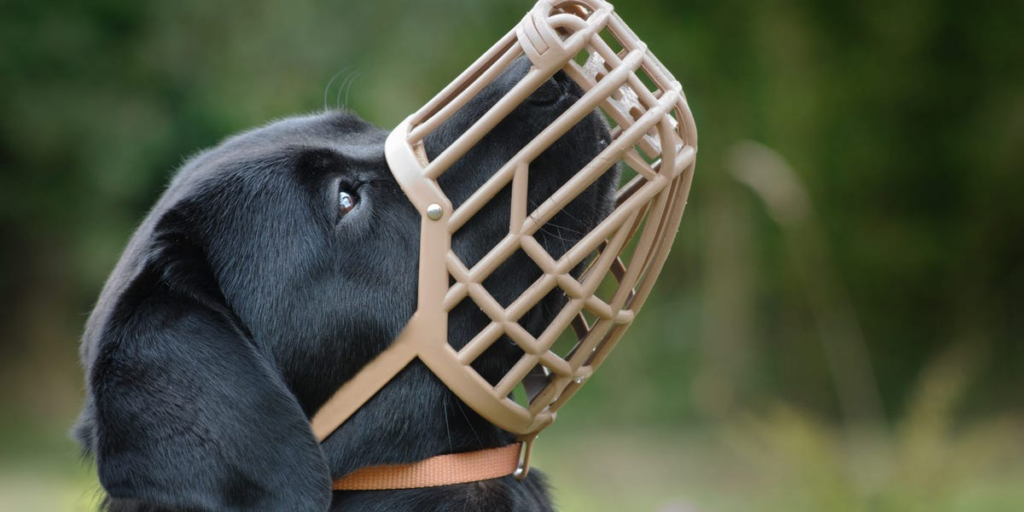Muzzles can be an important tool for dog owners to prevent biting and eating garbage off the street while you work on training.
Many dogs will only need a muzzle for special situations like a visit to the vet, but others may need to wear a muzzle on daily walks, until they can learn to change their behavior.
Important: Muzzles don’t change a dog’s reactions or behavior. They’re a temporary device for certain situations while you train your dog to be comfortable.
Here are some of the benefits of dog muzzles, and how to know when you should use one.
If a dog is afraid of people, loud noises, or any sort of stimulus, he may lunge, growl, or try to bite you or passers-by.
“We might use a muzzle on this dog while we teach him that people are nice and not the enemy,”says Teoti Anderson, CPDT-KA, a certified professional dog trainer at A Dog’s Best Friend in Fort Lauderdale, FL.
Injured dogs may also be more likely to bite, especially if their owner or a vet is caring for their injuries.
“It’s a lot easier to administer first aid to a dog if they can’t bite you,” Anderson says. This is where using a muzzle comes in handy.
General advice: Even if your dog isn’t generally aggressive, it may be helpful to use a muzzle in certain circumstances, like after your dog has had a medical procedure or if you’re in a crowded area.
When people see a cute dog in public, they may be tempted to pet it. However, fearful dogs may see this as a threat and react with a bite. This can be especially true for children, who may not be used to dogs or know how to approach a dog gently.
If your dog has a history of biting or aggression, putting a muzzle on while you’re out in public can help signal to other people to keep their distance.
“Most people see a dog in a muzzle and assume the dog is dangerous,” Anderson says. Even if your dog is usually mild-tempered, a muzzle can offer protection for the off-chance that they lash out.
When your dog experiences something for the first time, you can never predict exactly how they’ll respond.
“Using a muzzle may be particularly useful if your dog is not well trained or the environment is too stimulating,” says Sagi Denenberg, DVM, DACVB, Senior Clinician in Behavior at the University of Bristol.
But bringing dogs into a new environment with a muzzle isn’t enough to help them get acclimated. It’s important to warm your dog up gradually — this means giving treats for good behavior and taking breaks when needed.
“The muzzle won’t make the dog worse or better, but it will protect the public,” Houpt says.
Some dogs don’t mind being groomed, but others may find it frightening or overwhelming, leading to aggressive behavior.
Bathing or nail trimming can set off fearful reactions in dogs, especially if it’s done by a groomer the dog doesn’t know.
Keeping a muzzle on your dog can help keep you or a professional groomer safe while your dog gets used to the grooming process.
Many countries place restrictions on dog breeds that are considered dangerous. These restrictions can include banning those breeds from being sold or requiring that the dogs wear muzzles in public.
Pitbull terriers are the most common breeds listed, but some countries also have muzzle requirements for breeds like Rottweiler and Mastiffs.
Countries that have muzzle regulations for certain dog breeds include:
Some US states have restrictions as well — you can find a more details in this list from DogBite.org.
Properly training your dog to wear a muzzle can give you the opportunity to travel more places with them, particularly if your dog’s breed is considered to be higher risk.
Some dogs are prone to eat anything they find on the ground, putting them at risk of being poisoned by something toxic or choking on large objects like a chicken bone.
If your dog has a history of this behavior, a muzzle can stop your dog from eating garbage and keep him safe while on walks.
However, a key point to remember is that a muzzle prevents the dog from picking up garbage, but it doesn’t teach them to stop. “A muzzle is alongside training and behavior modification, not instead,” Denenberg says.
There are three main types of muzzles for dogs:
“For training, it’s best to use a basket muzzle. This allows a dog to pant, breathe freely, drink water and take treats,” says Anderson.
Important: Using a soft muzzle for an extended period can potentially be dangerous since dogs can easily overheat if they aren’t able to pant.
It’s best to get your dog used to a muzzle gradually, and you can start by putting sticky food like peanut butter in the muzzle for your dog to lick, says Katherine Houpt VMD, PhD, DACVB, a professor of behavioral medicine at Cornell University.
Muzzles shouldn’t be used for behaviors that aren’t dangerous, like barking or chewing.
A muzzle can be an important tool to help keep dogs safe and stop them from harming people and other dogs around them. This is especially important in situations where your dog may be afraid or in a new environment.
But it’s important to keep in mind that muzzles don’t actually change your dog’s reactions or behavior. To make real behavioral changes, “be sure to work with a professional trainer with experience in aggression and who uses modern, science-based reward training,” Anderson says.
Jump to

